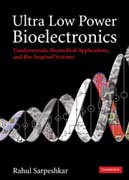
Ultra low power bioelectronics: fundamentals, biomedical applications and bio-inspired systems
Sarpeshkar, Rahul
This book provides, for the first time, a broad and deep treatment of the fields of both ultra low power electronics and bioelectronics. It discusses fundamental principles and circuits for ultra low power electronic design and theirapplications in biomedical systems. It also discusses how ultra energy efficient cellular and neural systems in biology can inspire revolutionary low powerarchitectures in mixed-signal and RF electronics. The book presents a unique,unifying view of ultra low power analog and digital electronics and emphasizes the use of the ultra energy efficient subthreshold regime of transistor operation in both. Chapters on batteries, energy harvesting, and the future of energy provide an understanding of fundamental relationships between energy use and energy generation at small scales and at large scales. A wealth of insightsand examples from brain implants, cochlear implants, bio-molecular sensing, cardiac devices, and bio-inspired systems make the book useful and engaging forstudents and practicing engineers. INDICE: Part I. Foundations: Ten chapters lay a foundation in device physics, noise, and feedback systems including nano scales in a highly original fashion, emphasizing intuitive thinking. This foundation is important in designing and analyzing ultra-low-power systems in both electronics and biology; Part II. Low-Power Analog and Biomedical Circuits: Five chapters present building-block circuits that are useful for ultra-low-power biomedical electronics and analog electronic systems in general; Part III. Low-Power RF and Energy-Harvesting Circuits for Biomedical Systems: Three chapters provide an in-depth description of energy-efficient power and data radio-frequency (RF) links that are fundamental to biomedical systems; Part IV. Biomedical Electronic Systems: Two chapters provide an in-depth look at ultra-low-power implantable electronics and ultra-low-power noninvasive electronics for biomedical applications, respectively. Case studies for cochlear implants for the deaf, brain implants for the blind and paralyzed, wearable cardiac devices, and biomolecular sensing are provided; Part V. Principles for Ultra-Low-Power Analog and Digital Design: Two chapters discuss principles for ultra-low-power digital design and ultra-low-power analog and mixed-signal design, respectively. The chapters identify tenfundamental principles that are common in both biology and electronics, analog and digital design; Part VI. Bio-Inspired Systems: A chapter on neuromorphicelectronics discusses electronics inspired by neurobiology followed by a chapter that discusses a novel form of electronics termed Cytomorphic Electronics,electronics inspired by cell biology. These chapters discuss applications of bio-inspired systems to engineering and medicine, deep connections between chemistry and electronics, and provide a unifying viewpoint of ultra-low-power design in biology and in electronics; Part VII. Energy Sources: A chapter on batteries and electrochemistry discusses how batteries work from a unique circuitviewpoint. The last chapter discusses energy harvesting in biomedical systemsat portable scales (vibration and body heat) and at larger scales (low-power cars and solar cells). Principles of low-power design are shown to extend fromsmall scales in electronics to larger scales and to non-electrical systems. This book reveals the deep connections between energy use and energy generation, vital for sustainable energy systems of the future.
- ISBN: 978-0-521-85727-7
- Editorial: Cambridge University Press
- Encuadernacion: Rústica
- Páginas: 889
- Fecha Publicación: 01/05/2010
- Nº Volúmenes: 1
- Idioma: Inglés
